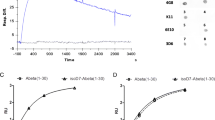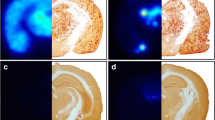Abstract
Alzheimer’s disease (AD), a debilitating neurodegenerative disease is caused by aggregation and accumulation of a 39–43 amino acid peptide (amyloid β or Aβ) in brain parenchyma and cerebrovasculature. The rational approach would be to use drugs that interfere with Aβ–Aβ interaction and disrupt polymerization. Peptide ligands capable of binding to the KLVFF (amino acids 16–20) region in the Aβ molecule have been investigated as possible drug candidates. Retro-inverso (RI) peptide of this pentapeptide, ffvlk, has been shown to bind artificial fibrils made from Aβ with moderate affinity. We hypothesized that a ‘detox gel’, which is synthesized by covalently linking a tetrameric version of RI peptide ffvlk to poly(ethylene glycol) polymer chains will act like a ‘sink’ to capture Aβ peptides from the surrounding environment. We previously demonstrated that this hypothesis works in an in vitro system. The present study extended this hypothesis to an in vivo mouse model of AD and determined the therapeutic effect of our detox gel. We injected detox gel subcutaneously to AD model mice and analyzed brain levels of Aβ-42 and improvement in memory parameters. The results showed a reduction of brain amyloid burden in detox gel treated mice. Memory parameters in the treated mice improved. No undesirable immune response was observed. The data strongly suggest that our detox gel can be used as an effective therapy to deplete brain Aβ levels. Considering recent abandonment of failed antibody based therapies, our detox gel appears to have the advantage of being a non-immune based therapy.






Similar content being viewed by others
References
Bayer AJ, Bullock R, Jones RW, Wilkinson D, Paterson KR, Jenkins L, Millais SB, Donoghue S (2005) Evaluation of the safety and immunogenicity of synthetic Abeta42 (AN1792) in patients with AD. Neurology 64:94–101
Chorev M, Goodman M (1995) Recent developments in retro peptides and proteins—an ongoing topochemical exploration. Trends Biotechnol 13:438–445
Demattos RB, Bales KR, Cummins DJ, Paul SM, Holtzman DM (2002) Brain to plasma amyloid-beta efflux: a measure of brain amyloid burden in a mouse model of Alzheimer’s disease. Science 295:2264–2267
Dintzis HM, Symer DE, Dintzis RZ, Zawadzke LE, Berg JM (1993) A comparison of the immunogenicity of a pair of enantiomeric proteins. Proteins 16:306–308
Herve M, Maillere B, Mourier G, Texier C, Leroy S, Menez A (1997) On the immunogenic properties of retro-inverso peptides. Total retro-inversion of T-cell epitopes causes a loss of binding to MHC II molecules. Mol Immunol 34:157–163
Holcomb L, Gordon MN, McGowan E, Yu X, Benkovic S, Jantzen P, Wright K, Saad I, Mueller R, Morgan D, Sanders S, Zehr C, O’campo K, Hardy J, Prada CM, Eckman C, Younkin S, Hsiao K, Duff K (1998) Accelerated Alzheimer-type phenotype in transgenic mice carrying both mutant amyloid precursor protein and presenilin 1 transgenes. Nat Med 4:97–100
Hsiao K, Chapman P, Nilsen S, Eckman C, Harigaya Y, Younkin S, Yang F, Cole G (1996) Correlative memory deficits, Abeta elevation, and amyloid plaques in transgenic mice. Science 274:99–102
Kawarabayashi T, Younkin LH, Saido TC, Shoji M, Ashe KH, Younkin SG (2001) Age-dependent changes in brain, CSF, and plasma amyloid (beta) protein in the Tg2576 transgenic mouse model of Alzheimer’s disease. J Neurosci 21:372–381
King DL, Arendash GW (2002) Behavioral characterization of the Tg2576 transgenic model of Alzheimer’s disease through 19 months. Physiol Behav 75:627–642
Kokkoni N, Stott K, Amijee H, Mason JM, Doig AJ (2006) N-methylated peptide inhibitors of beta-amyloid aggregation and toxicity. Optimization of the inhibitor structure. Biochemistry 45:9906–9918
Matsuoka Y, Saito M, Lafrancois J, Gaynor K, Olm V, Wang L, Casey E, Lu Y, Shiratori C, Lemere C, Duff K (2003) Novel therapeutic approach for the treatment of Alzheimer’s disease by peripheral administration of agents with an affinity to beta-amyloid. J Neurosci 23:29–33
Morgan D, Gordon MN (2008) Amyloid, hyperactivity, metabolism: theoretical comment on Vloeberghs et al. (2008). Behav Neurosci 122:730–732
Orgogozo JM, Gilman S, Dartigues JF, Laurent B, Puel M, Kirby LC, Jouanny P, Dubois B, Eisner L, Flitman S, Michel BF, Boada M, Frank A, Hock C (2003) Subacute meningoencephalitis in a subset of patients with AD after Abeta42 immunization. Neurology 61:46–54
Sagare A, Deane R, Bell RD, Johnson B, Hamm K, Pendu R, Marky A, Lenting PJ, Wu Z, Zarcone T, Goate A, Mayo K, Perlmutter D, Coma M, Zhong Z, Zlokovic BV (2007) Clearance of amyloid-beta by circulating lipoprotein receptors. Nat Med 13:1029–1031
Selkoe DJ (1996) Amyloid beta-protein and the genetics of Alzheimer’s disease. J Biol Chem 271:18295–18298
Sigurdsson EM, Scholtzova H, Mehta PD, Frangione B, Wisniewski T (2001) Immunization with a nontoxic/nonfibrillar amyloid-beta homologous peptide reduces Alzheimer’s disease-associated pathology in transgenic mice. Am J Pathol 159:439–447
Small DH, Mok SS, Bornstein JC (2001) Alzheimer’s disease and Abeta toxicity: from top to bottom. Nat Rev Neurosci 2:595–598
Soto C, Sigurdsson EM, Morelli L, Kumar RA, Castano EM, Frangione B (1998) Beta-sheet breaker peptides inhibit fibrillogenesis in a rat brain model of amyloidosis: implications for Alzheimer’s therapy. Nat Med 4:822–826
Strazielle N, Ghersi-Egea JF, Ghiso J, Dehouck MP, Frangione B, Patlak C, Fenstermacher J, Gorevic P (2000) In vitro evidence that beta-amyloid peptide 1–40 diffuses across the blood-brain barrier and affects its permeability. J Neuropathol Exp Neurol 59:29–38
Sundaram RK, Kasinathan C, Stein S, Sundaram P (2008) Detoxification depot for beta-amyloid peptides. Curr Alzheimer Res 5:26–32
Tjernberg LO, Lilliehook C, Callaway DJ, Naslund J, Hahne S, Thyberg J, Terenius L, Nordstedt C (1997) Controlling amyloid beta-peptide fibril formation with protease-stable ligands. J Biol Chem 272:12601–12605
Tjernberg LO, Näslund J, Lindqvist F, Johansson J, Karlström AR, Thyberg J, Terenius L, Nordstedt C (1996) Arrest of beta-amyloid fibril formation by a pentapeptide ligand. J Biol Chem 271(15):8545–8548
Zhang G, Leibowitz MJ, Sinko PJ, Stein S (2003) Multiple-peptide conjugates for binding beta-amyloid plaques of Alzheimer’s disease. Bioconjugate Chem 14:86–92
Acknowledgments
The authors thank Rahul Kuppuraj for his technical assistance. This research was supported by an Small Business Innovative Research (SBIR) grant to Pazhani Sundaram (5R44 AG023457). Financial support from NIH in the form of an SBIR phase II grant (AG023457) is gratefully acknowledged.
Author information
Authors and Affiliations
Corresponding author
Rights and permissions
About this article
Cite this article
Sundaram, R.K., Kasinathan, C., Stein, S. et al. Novel Detox Gel Depot Sequesters β-Amyloid Peptides in a Mouse Model of Alzheimer’s Disease. Int J Pept Res Ther 18, 99–106 (2012). https://doi.org/10.1007/s10989-011-9283-7
Accepted:
Published:
Issue Date:
DOI: https://doi.org/10.1007/s10989-011-9283-7




